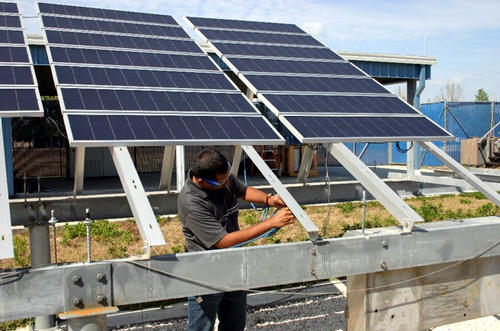 Gainesville’s feed-in tariff program is limited to 4 megawatts of solar PV each year. The program is already fully subscribed through 2015 — a 24-megawatt commitment.Photo courtesy U.S. NRELClean energy advocates in Europe have long considered the feed-in tariff as an antidote to the industrial world’s fossil fuel dependency. Now, the United States and Canada are starting to catch on as well.
Gainesville’s feed-in tariff program is limited to 4 megawatts of solar PV each year. The program is already fully subscribed through 2015 — a 24-megawatt commitment.Photo courtesy U.S. NRELClean energy advocates in Europe have long considered the feed-in tariff as an antidote to the industrial world’s fossil fuel dependency. Now, the United States and Canada are starting to catch on as well.
Feed-in tariffs (FITs) guarantee that anyone who generates electricity from a renewable energy source — whether they are a homeowner, small business, or large electric utility — is able to sell that electricity into the grid and receive long-term payments for each kilowatt-hour produced. Payments are set at pre-established rates, often higher than what the market would ordinarily pay, to ensure that developers earn profitable returns.
The FIT is credited for the rapid deployment of wind and solar power among world renewable energy leaders Denmark, Germany, and Spain this past decade. Similar policies have since been adopted by many other countries, leading the FIT to become the most prevalent tool for promoting renewables.
In North America, its adoption has been relatively slow. As public support for renewable energy increases, however, more governments are adopting FIT policies — often as a complement to the widely used Renewable Portfolio Standards (RPS) that require utilities to purchase minimum amounts of renewable electricity.
Several U.S. states and Canadian provinces began serious consideration of the FIT last year. More than a dozen states, one province, and numerous municipalities have since implemented some form of FIT.
“We’ve reached a tipping point where a feed-in tariff is no longer such an odd idea for America,” said Paul Gipe, the author of several books on wind energy and a FIT advocate. “In fact, it’s the best idea for rapid development of the massive amount of renewable energy that’s needed now.”
Renewable energy projects have often struggled to gain the confidence of investors, a problem the FIT policy addresses by ensuring that anyone with a sun-drenched roof or windy backyard may receive funding for a set period of time, normally 15-20 years.
“A lot of the charm of the feed-in tariff is solid, take-it-to-the-bank security and confidence for the investing community,” said U.S. Representative Jay Inslee, a sponsor of legislation that would establish a nationwide FIT, at a Washington, D.C. briefing earlier this month. “You get access to what is very difficult to get right now: financing.”
Not all FIT policies are created equal. The North American programs enacted to date often limit the level of economic incentive, the project size, and the renewable energy source, compared to large-scale programs enacted in Europe. Small-scale renewable energy advocates are praising FIT programs approved this year in Gainesville, Florida; Vermont; and Ontario as examples that North America should follow.
Gainesville, Florida
Florida, the Sunshine State, is blessed with bountiful solar resources to support renewable electricity. In the northern city of Gainesville, the municipal utility has helped ratepayers purchase their own solar panels since 1997. The program has partially financed some 40,000 watts of solar photovoltaic (PV) panels, but until recently there was no incentive for homeowners to install the panels properly.
“We weren’t getting energy bang for the buck,” said John Crider, an engineer with Gainesville Regional Utilities’ strategic planning department. “People could get the rebate check and put their solar panel in the shade.”
Last year, Assistant General Manager Ed Regan visited Germany, the world’s leader in grid-connected solar PV, on a trip coordinated with the Solar Electric Power Association. Impressed by Germany’s FIT policy, Regan convinced the Gainesville City Commission to approve the first FIT for solar PV in the United States. The utility promised that solar providers who signed up for the program before 2011 would earn $0.32 per kilowatt hour for 20 years, an estimated 4-6 percent return on investment.
“We assume, as time goes on, it will be cheaper to buy and install solar equipment,” Crider said. “The rate we pay goes down as well, to keep the return ideally constant.”
The utility, which is otherwise reliant on coal and natural gas for its power generation, wanted to be sure that electricity costs would not increase more than 1 percent due to the FIT, Crider said. The decision led the utility to limit the program to 4 megawatts total of solar PV each year. The program is already fully subscribed through 2015 — a 24-megawatt commitment. Before the Gainesville program, the entire state of Florida had installed 2.5 megawatts of solar electricity capacity.
The FIT gained the city’s support mostly to boost the local economy. More than 220 companies in Florida produce, sell, or install solar PV products, according to the Apollo Alliance, a San Francisco-based organization that champions “green jobs” nationwide.
“Our primary motive is not to get the cheapest energy and keep profits high for investors, because we don’t have investors,” Crider said. “For the municipality, we have a larger vision…. Create a local, thriving marketplace for local solar providers.”
Vermont
With two-thirds of Vermont’s electricity contracts set to expire in 2012, the state was in a position this year to change its energy portfolio. Meanwhile, Vermont was far from its 2025 goal of 25-percent renewable energy — renewables were supplying less than 10 percent.
The state offered a “net-metering” program that allowed residents to feed renewably generated electricity into the grid, offsetting some or all of their electric bills. Hundreds of small-scale systems resulted, but these combined to meet a mere 0.02 percent of the state’s electricity load.
“We were trying to alter the entire energy paradigm, but we were on a very slow trajectory,” said Andrew Perchlik, executive director of Renewable Energy Vermont.
The net-metering program did not allow participants to turn a profit, a problem given that small-scale power generation projects required the same costly permits as commercial power plants. Too few Vermonters had reason to participate.
Legislators had considered adopting a FIT, but the policy lacked grassroots support until a new coalition of business leaders, environmentalists, and utility executives formed a renewable energy consensus. The group met before the state’s politicians convened in January and settled on the framework of what would become Vermont’s first FIT, which they call a “standard offer.”
“Increasingly, utilities are realizing that customers are asking for renewable energy. In the long run, it will be less expensive than the alternative,” said Robert Dostis, a former state House of Representatives energy chairman who now directs external affairs for Green Mountain Power. “By being at the table, we were able to contain the enthusiasm of some of the renewable energy advocates and have them understand the rate impact of some of their ideas.”
The legislature settled on a 50-megawatt program that limited individual projects to 2.2 megawatts each. Starting in January 2010, 20-year contracts will be available for developers of large- and small-scale wind, solar, and biogas power projects.
Opponents said the public would reject the idea of paying more for renewable energy projects — the highest rate, $0.30 per kilowatt-hour of solar energy, far exceeded the $0.04 many ratepayers were being charged at the time. “That was not the case at all,” Perchlik said. “Some 80 percent wanted renewable energy, and they were willing to pay 5 percent more.”
The energy bill cleared the Democrat-controlled legislature easily. In May, Republican governor Jim Douglas allowed the bill to become law despite his concerns about it. He said the FIT “fails to recognize the current viability of renewable energy in a competitive setting and will needlessly increase costs to Vermont consumers so as to subsidize this one favored business sector.”
Although program specifics have yet to be finalized, Vermonters are expressing growing interest. Dostis predicts that the program will fulfill its 50-megawatt limit by 2012. “I think this is really going to propel development,” he said.
Ontario
During the 2007 provincial campaign, Ontario’s Liberal party promised it would close every coal-fired power plant across the province by 2014. Premier Dalton McGuinty said the plant closures would benefit human health and meet half of the party’s commitment to reduce greenhouse gases 15 percent below 1990 levels by 2020.
Following the election, the Liberal party secured 71 of the Legislative Assembly’s 107 seats. Despite clear political support, shuttering 18 percent of the province’s power source is no easy feat. The Liberals had already pledged to close the coal plants during their previous term, only to push back their own deadline.
Since 2006, the Ontario Power Authority (OPA) began offering a FIT system that provided 20-year payments of 11 Canadian cents (US$0.09) per kilowatt-hour for small-scale hydro, wind, and biomass power projects, and 42 Canadian cents (US$0.34) for solar projects. More than 1,000 megawatts of projects were installed during the first year, but renewable energy advocates criticized the payments, particularly for solar energy, as too small.
In March, the province announced that its proposed Green Energy and Green Economy Act would establish a revised FIT modeled after Germany’s. The bill set payments for on-shore, off-shore, and community-based wind power; rooftop PV and ground-mounted PV power; small hydropower; and various biomass power options. Payments would depend on the project size for each technology.
The proposal was instantly applauded by renewable energy supporters. “The Green Energy Act is the most progressive renewable energy policy in North America in three decades,” said Gipe, who advised the Ontario Sustainable Energy Association. “There was a decision to pay what it costs to develop renewable energy. It’s clear to the public, transparent to everyone.”
An OPA-conducted survey found 150 developers who were interested in the new FIT and were willing to construct 15,000 megawatts of electric capacity — enough to produce the equivalent of 20 percent of Ontario’s electricity consumption.
Gipe also solicited support from Ontario’s farmers, whom he advised would be eligible to receive payments for wind turbines on their property.
“I went to every farm group I could,” Gipe said. “This is an opportunity to revitalize the Ontario economy … not just to revitalize the rural economy, but the entire industrial economy of Ontario.”
The proposal was approved in May. It now stands as the most generous FIT policy in North America.
This article is a product of Eye on Earth, Worldwatch Institute’s online news service. For permission to reprint Eye on Earth content, please contact Juli Diamond at jdiamond@worldwatch.org.



